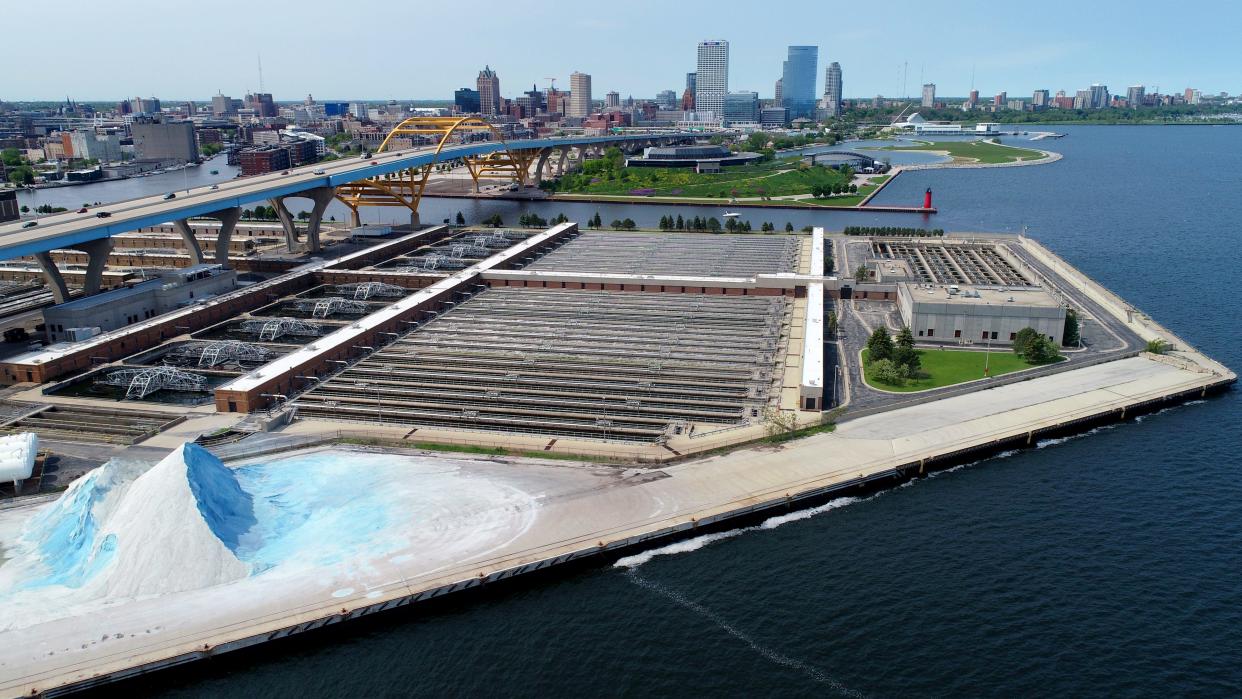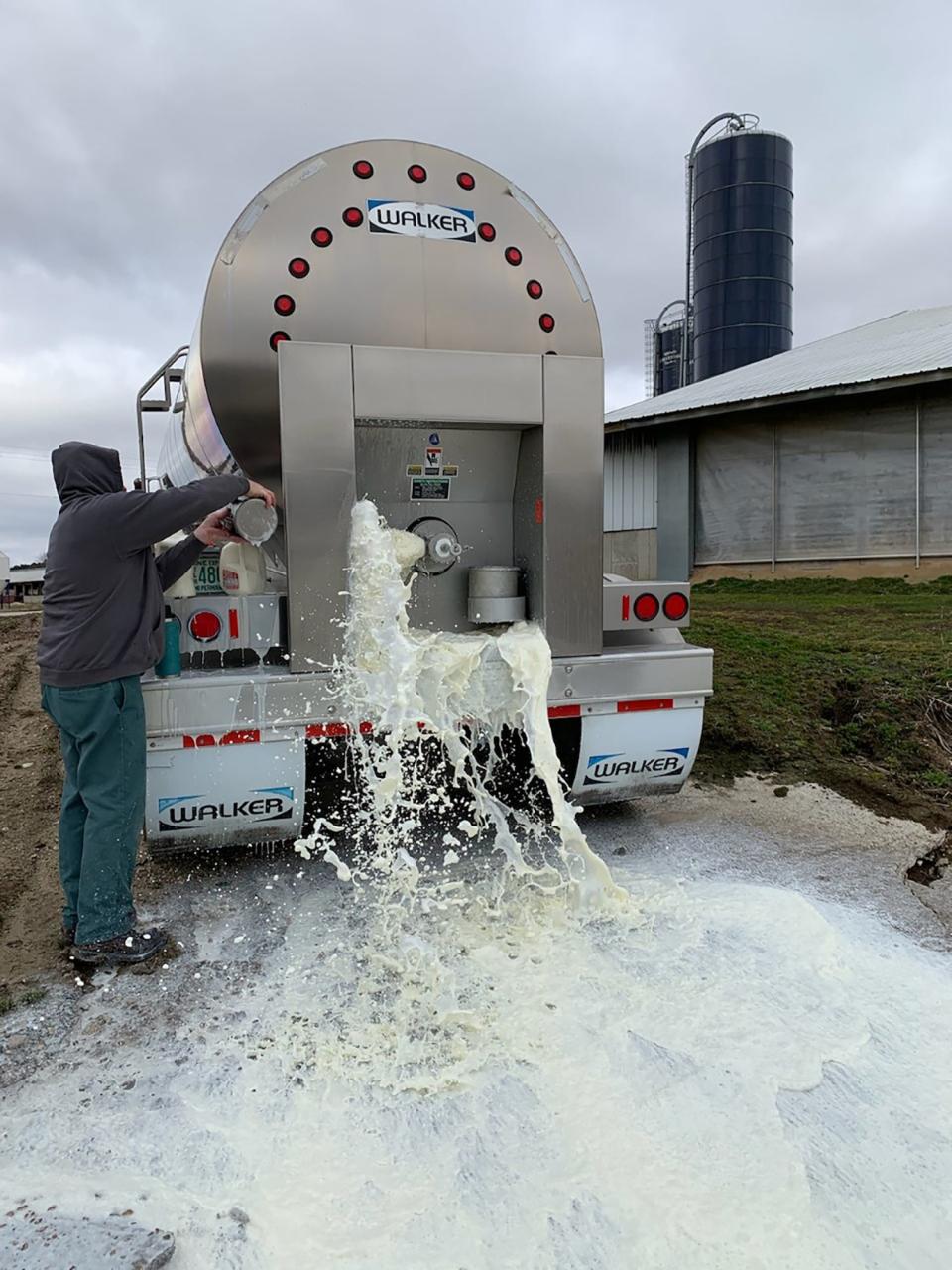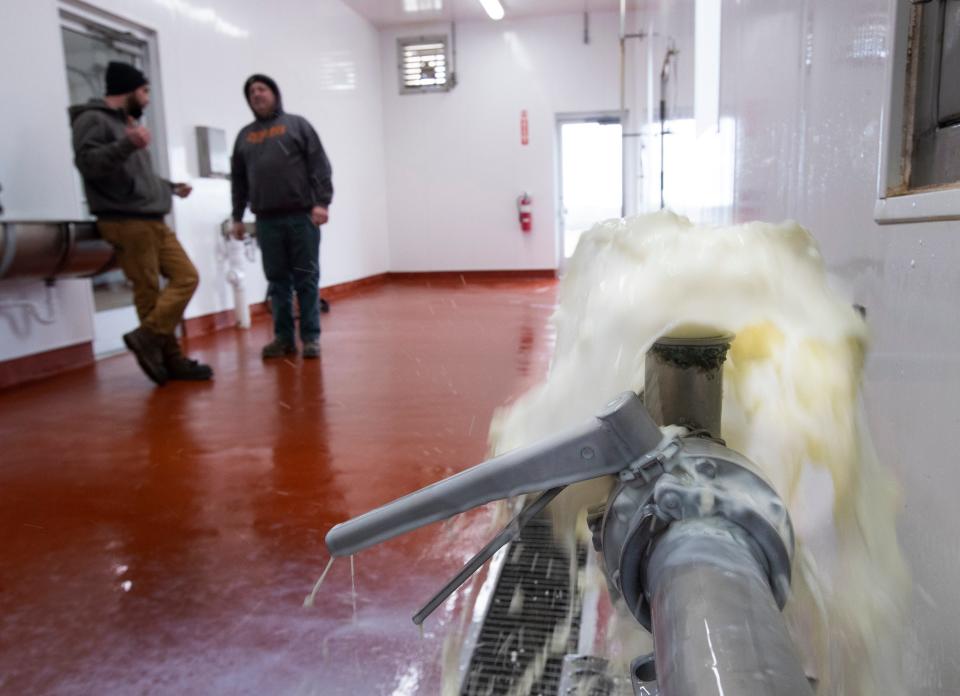Truckloads of fresh farm milk are dumped into Milwaukee's sewerage system

Truckloads of fresh farm milk have been flushed down the drain into Milwaukee’s sewer system recently as dairy plants, filled to the brim, couldn't accept more of the highly perishable commodity, the Milwaukee Journal Sentinel, part of the USA TODAY Network, learned this week.
The milk was treated to comply with state and federal environmental regulations, including the federal Clean Water Act, before it went into the wastewater treatment system, according to the Milwaukee Metropolitan Sewerage District.
“It has to be treated to a level that’s safe,” said MMSD spokesman Bill Graffin.
“It comes to us, and then we have to treat it to what we're regulated on, before we can discharge that water to Lake Michigan,” he said.
Graffin said he didn’t know how much milk has been flushed into the system but that recently it had declined to around five truckloads a week. A full truckload would be approximately 6,500 gallons, according to dairy industry sources.
The milk came from Wisconsin dairy farms, probably on the east side of the state, and was processed by Earth Environmental, a waste disposal services firm in Cudahy.
Earth Environmental treated it to comply with the district's requirements, MMSD said, as untreated raw milk flushed into the sewers would be a violation of regulations and would raise havoc with the wastewater treatment system.
Earth Environmental could not be reached to answer Journal Sentinel questions Monday. On its website, the company says it handles hazardous and non-hazardous waste materials.
It’s unknown for how long the Milwaukee sewerage district, which serves nearly 30 communities and has thousands of miles of sewer pipe, has received discarded farm milk. Previously it’s handled whey, a byproduct of cheesemaking, and food waste that's gone into a separate anaerobic waste digester.
But fresh farm milk going into the state's largest sewer system, and eventually as wastewater into Lake Michigan, is just "jaw dropping," said Peter Hardin, publisher of The Milkweed, a dairy farming publication in Brooklyn, Wisconsin.
Money down the drain for struggling farmers
One thing's certain. The dumping of fresh milk is money down the drain for dairy farmers already struggling with declining incomes and rising expenses.
“It’s pretty tragic,” said Jim Goodman, a retired farmer from Wonewoc and board president of the National Family Farm Coalition.
Dairy plants in the Upper Midwest have been overloaded with milk used to make cheese, butter and other products. When one Minnesota plant was ordered to close for around 30 days, because of wastewater issues, the 45 farms it supported were told they’d have to start dumping their milk, a highly perishable commodity if not processed quickly.
Farmers posted videos expressing their frustration and anger, the Wisconsin State Farmer reported.
"How is June Dairy Month going for me? It ain't worth a crap," one farmer said on social media.

In the spring of 2020, a farm near West Bend opened the spigot and flushed hundreds of thousands of pounds of milk into a wastewater lagoon because there was nowhere else for it to go.
The state Department of Natural Resources said that if the dumping of raw, unpasteurized milk wasn't done correctly, it could get into public waterways, reducing the oxygen content and killing aquatic life.
Sometimes the unwanted farm product has ended up in manure pits.
“Now," Goodman said, "it's being run through a sewer system. That’s pretty sickening."

Markets get flooded with excess milk production
Dairy farmers are dependent on a limited number of processors that are sometimes hamstrung by reduced market demand, like when COVID-19 forced the closure of restaurants, or there's simply too much milk.
Farms are so productive these days, partly from increased size of the operations and improved cow genetics, they can quickly flood the marketplace with milk, beef, and other commodities.
Moreover, farmers who have invested heavily in their milking operation can’t afford to just turn off the spigot. Instead, as profit margins shrink from supply-and-demand getting out of balance, they sometimes try to squeeze out ever-higher amounts of milk to cover their costs — even if it adds to the overall surplus.
"We've been down this road before," Goodman said.
'Public health has lost the war': States legalize raw milk, despite public health warnings
The prices farmers receive for their unprocessed, unpasteurized milk are largely determined by the forces of supply and demand and government programs. Minimum prices are set by the U.S. Department of Agriculture using complicated formulas based on the wholesale market value of various dairy products such as cheese, butter and whey.
Many farmers see themselves as pawns in an agricultural system stacked against them. Faced with few options to control what they receive for their products, they ramp up production and hope markets don't buckle under the strain.
Prices in the grocery store often remain high even as farmers are paid less.
"It shouldn't be that way when they're having to dump milk," Goodman said.
Milk prices paid to farmers at lowest level in years
A year ago, the price Wisconsin farmers received for their milk reached a record high of more than $25 per hundred pounds, around 8.6 gallons, which encouraged many to ramp up production. Since then, as the market adjusted, the price has plummeted to less than $15 per hundred pounds, one of the lowest levels in years.
But "there’s still more milk than we need,” said John Umhoefer, executive director of the Wisconsin Cheesemakers Association.
Ninety percent of Wisconsin milk is made into cheese. That’s more than 3 billion pounds per year, but the plants are still getting too much milk and are struggling to find enough hired help to fill all the work shifts.
Labor is one of the biggest issues, Umhoefer said.
Efforts have been made to get dairy products to food pantries in order to reduce stockpiles built up in commercial warehouses, but that's not always affordable or practical.
More: Antibiotics for humans, livestock found in waters flowing to Lake Erie
Farms at risk of going out of business
It could take a culling of dairy cattle, usually sold off for beef, to get the supply-and-demand ratio for milk back in balance. Meanwhile, many dairy farms are at risk of going under as their expenses continue to rise.
Since 2000, more than 70% of U.S. dairy farms have closed for good, unable to stay financially afloat in a market increasingly dominated by the biggest operators, according to Goodman.
It’s been “a disaster for dairy farmers, rural communities, consumers, the environment and animal welfare,” he said.
Discarded milk represents a massive amount of work wasted on the farm, including planting and harvesting crops, raising livestock and milking cows. Generations of farm families and their communities are at risk when milk markets collapse and milk has to be dumped.
"For farmers, this has got to be awful," Goodman said.
This article originally appeared on USA TODAY NETWORK: Truckloads of farm milk dumped into Milwaukee sewerage system

